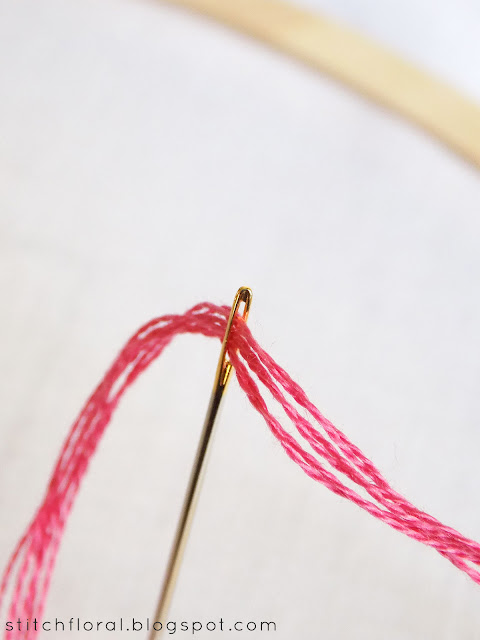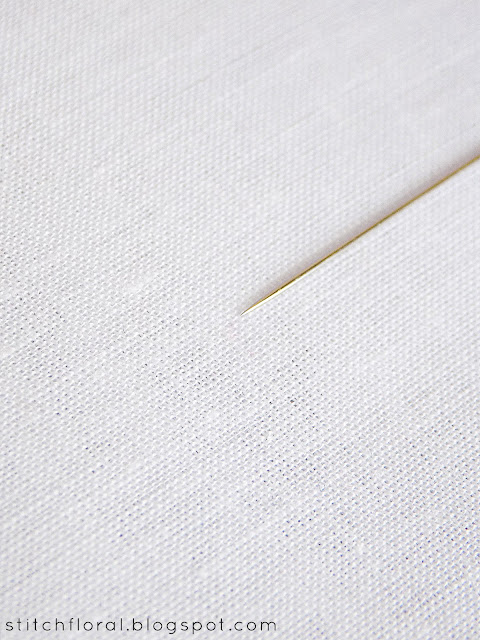As a designer of embroidery patterns, I always cringe when I give recommendations on which needle to use for working my patterns. Because I do realize that most probably you will take another fabric to work it than what I chose, and some of you might want to change the number of strands you use in the needle.
I get it because I'm a
fellow stitcher like everyone else and the desire to add something
from yourself to an existing design, work it your way,
is quite familiar to me. Or, in other cases, it might be just hard to
find the same fabric or thread that you see in the list, so you might
opt to take materials you have easier access to. And that's
completely fine too.
That's why I always cringe
when I write the needle recommendation. Because the thing is, the best choice will be heavily depending on several conditions,
including the fabric you use and the thickness of the thread you are
using.
However, writing a whole
essay on the topic of needles in a PDF document where the main focus
should be instructions to work the pattern would be at least
confusing for the reader, and in the worst case scenario might just
scare you away with too much of information to process...
Nevertheless, in my mind,
the topic is worth discussion. And although I already touched upon it
in the post of 10 things to remember about hand embroidery needles, let's take a closer look at just this one issue to get
it clearer.
4 conditions of choosing embroidery needle
For now, let's put aside
the types of embroidery needles and imagine that you
have a mixed stack of various needles at home or your working studio
and you have to make a choice on which one you need for this
particular project. Or let's say you are in a craft store standing in
front of a showcase with lots of different needles and your head is
dizzy with all the names and shapes. Which one should you choose?
The main things you should
pay attention to when choosing embroidery needles are following:
- Tip
- Size
- Eye
- Width
1. Tip
The tip of a needle can be
blunt or sharp.
Surface embroidery will
always call for a sharp tip since we need to pierce through the
weaving fibers of the fabric and sometimes even through the other
stitches. Crewel embroidery will also require a sharp-tipped needle.
The areas of hand
embroidery that welcome blunt-tipped needles include cross stitch,
counted canvas work, drawn work, blackwork, etc., which are worked on
Aida and other even weaved fabric with clear visible holes. With these
embroidery styles you usually would need to slide your needle through
the hole in the weaving and a rounded tip makes it easier to slip the
needle exactly there and not to pierce through the fibers of the
fabric.
Blunt tipped needles also
have another use, though. I, for one, don't do neither cross stitch
nor canvas work, so why would I have needles with dull tips at my
stash?
Because they are most
suitable for stitches that include some kind of weaving like detached buttonhole or
interlaced back stitch. A
rounded tip will not tug on the fibers of the thread in your stitches
so you won't have to worry about ruining your work.
2. Size
The general rule of the thumb is that the size of the needle should correspond to the
thickness of thread.
This is not something to
take literally, of course. You don't need to measure your needle and
thread to find the best match. You can determine that just by looking
and comparing the needles with the thread you are going to use.
In the picture above,
which needle suits more the thread in the middle?
The one on the right,
correct. Its shaft is longer, thicker, and sturdier, and more capable
of leading this thread in your stitching and for the thread to feel
more comfortable and secure.
3. Eye
And again, we have to take
into consideration our thread. The eye should be large enough to
accommodate thread in comfort.
Here is the needle from
the right from the previous picture, with the 6 strands of floss in
its eye. The floss still has some room to move and it doesn't look
crumpled and constrained.
And here is the needle
from the left. As you see, one strand of floss is the best option for
it. Add more and the thread will already feel a bit jammed there.
Why thread should have
some space and air in the eye of the needle and not be jammed?
When the needle passes
through the fabric, embroidery thread already goes through a certain
level of friction that does a certain level of damage to it. You
probably noticed that as you stitch and it comes to the part of the
thread which was in the eye, it often looks worn down. The best thing
in such cases is to finish your thread right there because it
lost its appeal.
So, the rule here is to
choose a needle that will let the thread sit comfortably in its eye.
4. Width
When we speak about the
width of the needle, most of the time it means that it should
correspond to the fabric and its density in weaving.
There are different types
of fabric that you can use for
hand embroidery and some of them are very densely woven, others are
not. Some, even if their weaving is dense, will be quite light, but
others will be sturdy like jeans fabric.
So,
the needle should also be suitable for the fabric you are going to
use.
In
the pictures above I'm using cotton muslin in 2 layers (as a ground
fabric and interlining). Cotton muslin is generally quite a light
type of fabric with dense weaving. So, the thicker needle from the
previous examples has a hard time to pass through it. And as it does,
it leaves a damaged hole behind. You can see how the weaving is
falling apart around the place where the needle is emerging.
This
kind of hole, my friends, is impossible to fix. It means that the
needle is too wide for this particular fabric. Or, if we look at it
from another perspective, if you have a thick thread and you need a
corresponding needle, then the problem might be in the poor choice of
fabric. Take something sturdier and with a looser weave.
When
the needle has an adequate size to the fabric, there is no resistance and therefore, no big damage
to the fabric as it passes through.
Yes,
a hole will most probably appear (I used 2 strands of floss for this
example. If I used 1 strand, the hole would be barely noticeable at
all).
But
after a couple of gentle strokes, the weaving will bounce back to its original
appearance. The needle tip is pointing at the place of the hole here,
but you can barely see it.
So,
these are the main conditions to consider when you choose embroidery
needle for your project.
Ultimately,
the order of choice will look as follows:
- The type of the needle according to the purpose (Tapestry needles, Crewel needles, Embroidery sharpies, etc). I talked about the types of the needle in this post previously, this is also where you can define whether you need a sharp tip or a blunt tip.
- Think about how the needle will correspond to the fabric in size and width.
- Think about how the needle will accommodate the thread it its eye.
When
all these conditions are thought through, the process of working your
embroidery project will be much smoother! :)






















Thank you! This is nicely presented, and makes common sense out of the multitude of choices available. Needles were one of the most confusing things when I was getting re-started, especially the ones that are called by different names.
ReplyDeleteAnd I still have to mull things over when starting a new project. I think this will help make the process easier.
akaGaga
Needles issue can be confusing, indeed! I personally have few favorite needles and just stick to them most of the time, because I mostly do the same style of embroidery using the same kinds of fabrics, haha
DeleteThank you that's a big help in choosing what needle may be best.
ReplyDeleteHappy to help :)
DeleteThank You So Much! I bought my things yesterday at a local bookstore and am so eager yet anxious to start ^_^
ReplyDeleteLots of Love & Gratitude,
from the Caribbean Island of Trinidad & Tobago.
Hope you have a lot of fun with it! :)
DeleteThank you!!
ReplyDeleteThank you
ReplyDelete